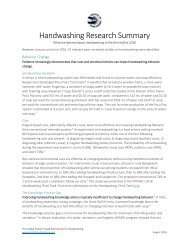WASH’ Nutrition
manuel_wash_nutrition_online
manuel_wash_nutrition_online
You also want an ePaper? Increase the reach of your titles
YUMPU automatically turns print PDFs into web optimized ePapers that Google loves.
Figure 8: Median age-specific incidences for diarrheal episodes per child per year from<br />
three reviews of prospective studies in developing areas<br />
6<br />
No. of episodes<br />
per person per year<br />
5<br />
4<br />
3<br />
2<br />
1<br />
0<br />
0-5 m 6-11 m 1 year 2 years 3 years 4 years<br />
AGE GROUP<br />
Source: The global burden of diarrheal disease, WHO 2003<br />
● 1955-1979<br />
● 1980-1990<br />
● 1990-2000<br />
Figure 9: Vicious CYCLE BETWEEN intestinal infections AND UNDERnutrition<br />
RESPIRATORY INFECTIONS<br />
Impaired immune function<br />
Impaired barrier protection<br />
HIV/<br />
AIDS<br />
Inadequate water, sanitation and hygiene<br />
Diarrhea and other intestinal<br />
infections<br />
Undernutrition<br />
Catabolism<br />
Malabsorption<br />
Nutrient sequestration<br />
Decrease dietary intake<br />
Source: Pathways linking WASH with nutrition (WHO, 2007), Brown 2003, adapted ACF<br />
2.2. NematodeS<br />
Caused by different species of parasitic worms, the infection is<br />
transmitted by eggs present in human feces, which in turn contaminate<br />
soil in areas where sanitation is poor. Infection can be caught easily by<br />
walking barefoot on the contaminated soil or eating contaminated food.<br />
Nematode infections interfere with nutrient uptake in children, which<br />
can lead to anemia, malnourishment and impaired mental and physical<br />
development. They pose a serious threat to children’s health, education,<br />
and productivity. 62 Parasitic, intestinal worms, such as schistosomes<br />
(contracted through bathing in, or drinking contaminated water) and soiltransmitted<br />
helminths (contracted through soil contaminated with feces)<br />
cause blood loss and reduced appetite, both of which negatively affect a<br />
child’s nutritional status. 63<br />
In developing countries every second,<br />
pregnant women and about 40% of preschool<br />
children are estimated to be anemic.<br />
Maternal anemia increases risks of poor<br />
outcomes during pregnancy and childbirth,<br />
risk of morbidity in children and reduced<br />
work productivity in adults. Iron-deficiency<br />
anemia (IDA) is aggravated by hookworm<br />
infections, malaria and other infectious<br />
diseases contracted through a poor WASH<br />
environment (WHO, 2015).<br />
NOTE<br />
62 - Deworm the World (2014)<br />
63 - Generation <strong>Nutrition</strong> (2015) “The role of water, sanitation and hygiene in fight against child undernutrition”<br />
<strong>WASH’</strong><strong>Nutrition</strong><br />
A practical guidebook<br />
35



